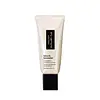Shu Uemura Unlimited Block : Booster Hydrating Primer SPF 50+ PA+++ Versus Laura Mercier Pure Canvas Primer
What's inside
What's inside
 Key Ingredients
Key Ingredients

 Benefits
Benefits

 Concerns
Concerns

 Ingredients Side-by-side
Ingredients Side-by-side

Water
Skin ConditioningAlcohol Denat.
AntimicrobialEthylhexyl Salicylate
UV AbsorberIsononyl Isononanoate
EmollientOctocrylene
UV AbsorberButyl Methoxydibenzoylmethane
UV AbsorberEthylhexyl Triazone
UV AbsorberBis-Ethylhexyloxyphenol Methoxyphenyl Triazine
Skin ConditioningCI 77891
Cosmetic ColorantMethylene Bis-Benzotriazolyl Tetramethylbutylphenol
UV FilterPropanediol
SolventIsopropyl Lauroyl Sarcosinate
Skin ConditioningSilica
AbrasiveCetearyl Alcohol
EmollientDiisopropyl Sebacate
EmollientCoco-Caprylate/Caprate
EmollientMica
Cosmetic ColorantPhenoxyethanol
PreservativeHomosalate
Skin ConditioningButylene Glycol
HumectantAmmonium Acryloyldimethyltaurate/Vp Copolymer
Polyglyceryl-10 Laurate
Skin ConditioningCetearyl Glucoside
EmulsifyingTocopherol
AntioxidantGlycerin
HumectantSodium Stearoyl Glutamate
CleansingCaprylyl Glycol
EmollientCaramel
Cosmetic ColorantCarbomer
Emulsion StabilisingInulin Lauryl Carbamate
Emulsion StabilisingTin Oxide
AbrasivePropylene Glycol
HumectantAdenosine
Skin ConditioningTrisodium Ethylenediamine Disuccinate
Xanthan Gum
EmulsifyingAlumina
AbrasiveIsopropyl Titanium Triisostearate
EmollientSorbitol
HumectantZea Mays Kernel Extract
Nelumbo Nucifera Flower Extract
Skin ConditioningCI 17200
Cosmetic ColorantPaeonia Suffruticosa Root Extract
Skin ProtectingSorbic Acid
PreservativeCitric Acid
BufferingWater, Alcohol Denat., Ethylhexyl Salicylate, Isononyl Isononanoate, Octocrylene, Butyl Methoxydibenzoylmethane, Ethylhexyl Triazone, Bis-Ethylhexyloxyphenol Methoxyphenyl Triazine, CI 77891, Methylene Bis-Benzotriazolyl Tetramethylbutylphenol, Propanediol, Isopropyl Lauroyl Sarcosinate, Silica, Cetearyl Alcohol, Diisopropyl Sebacate, Coco-Caprylate/Caprate, Mica, Phenoxyethanol, Homosalate, Butylene Glycol, Ammonium Acryloyldimethyltaurate/Vp Copolymer, Polyglyceryl-10 Laurate, Cetearyl Glucoside, Tocopherol, Glycerin, Sodium Stearoyl Glutamate, Caprylyl Glycol, Caramel, Carbomer, Inulin Lauryl Carbamate, Tin Oxide, Propylene Glycol, Adenosine, Trisodium Ethylenediamine Disuccinate, Xanthan Gum, Alumina, Isopropyl Titanium Triisostearate, Sorbitol, Zea Mays Kernel Extract, Nelumbo Nucifera Flower Extract, CI 17200, Paeonia Suffruticosa Root Extract, Sorbic Acid, Citric Acid
Water
Skin ConditioningMethyl Methacrylate Crosspolymer
Butylene Glycol
HumectantGlycerin
HumectantPropanediol
SolventTriethylhexanoin
MaskingIsopropyl Myristate
EmollientSynthetic Wax
AbrasivePhenoxyethanol
PreservativeSqualane
EmollientPlankton Extract
Skin ConditioningAmmonium Acryloyldimethyltaurate/Vp Copolymer
Hydroxyethyl Acrylate/Sodium Acryloyldimethyl Taurate Copolymer
Emulsion StabilisingSilica
AbrasivePolyvinyl Alcohol
BHT
AntioxidantAcrylates/C10-30 Alkyl Acrylate Crosspolymer
Emulsion StabilisingPolysorbate 60
EmulsifyingPotassium Hydroxide
BufferingCI 77491
Cosmetic ColorantCI 77492
Cosmetic ColorantWater, Methyl Methacrylate Crosspolymer, Butylene Glycol, Glycerin, Propanediol, Triethylhexanoin, Isopropyl Myristate, Synthetic Wax, Phenoxyethanol, Squalane, Plankton Extract, Ammonium Acryloyldimethyltaurate/Vp Copolymer, Hydroxyethyl Acrylate/Sodium Acryloyldimethyl Taurate Copolymer, Silica, Polyvinyl Alcohol, BHT, Acrylates/C10-30 Alkyl Acrylate Crosspolymer, Polysorbate 60, Potassium Hydroxide, CI 77491, CI 77492
 Reviews
Reviews

Ingredients Explained
These ingredients are found in both products.
Ingredients higher up in an ingredient list are typically present in a larger amount.
Ammonium Acryloyldimethyltaurate/Vp Copolymer (let's call it AAVC for short) is a synthetically created polymer. It's used as a film-forming agent and used to thicken the consistency of products.
AAVC is able to increase the consistency and viscosity of products due to its large molecule size. It also prevents ingredients from separating.
Butylene Glycol (or BG) is used within cosmetic products for a few different reasons:
Overall, Butylene Glycol is a safe and well-rounded ingredient that works well with other ingredients.
Though this ingredient works well with most skin types, some people with sensitive skin may experience a reaction such as allergic rashes, closed comedones, or itchiness.
Learn more about Butylene GlycolGlycerin is already naturally found in your skin. It helps moisturize and protect your skin.
A study from 2016 found glycerin to be more effective as a humectant than AHAs and hyaluronic acid.
As a humectant, it helps the skin stay hydrated by pulling moisture to your skin. The low molecular weight of glycerin allows it to pull moisture into the deeper layers of your skin.
Hydrated skin improves your skin barrier; Your skin barrier helps protect against irritants and bacteria.
Glycerin has also been found to have antimicrobial and antiviral properties. Due to these properties, glycerin is often used in wound and burn treatments.
In cosmetics, glycerin is usually derived from plants such as soybean or palm. However, it can also be sourced from animals, such as tallow or animal fat.
This ingredient is organic, colorless, odorless, and non-toxic.
Glycerin is the name for this ingredient in American English. British English uses Glycerol/Glycerine.
Learn more about GlycerinPhenoxyethanol is a preservative that has germicide, antimicrobial, and aromatic properties. Studies show that phenoxyethanol can prevent microbial growth. By itself, it has a scent that is similar to that of a rose.
It's often used in formulations along with Caprylyl Glycol to preserve the shelf life of products.
Propanediol is an all-star ingredient. It softens, hydrates, and smooths the skin.
It’s often used to:
Propanediol is not likely to cause sensitivity and considered safe to use. It is derived from corn or petroleum with a clear color and no scent.
Learn more about PropanediolSilica, also known as silicon dioxide, is a naturally occurring mineral. It is used as a fine, spherical, and porous powder in cosmetics.
Though it has exfoliant properties, the function of silica varies depending on the product.
The unique structure of silica enhances the spreadability and adds smoothness, making it a great texture enhancer.
It is also used as an active carrier, emulsifier, and mattifier due to its ability to absorb excess oil.
In some products, tiny microneedles called spicules are made from silica or hydrolyzed sponge. When you rub them in, they lightly polish away dead skin layers and enhance the penetration of active ingredients.
Learn more about SilicaWater. It's the most common cosmetic ingredient of all. You'll usually see it at the top of ingredient lists, meaning that it makes up the largest part of the product.
So why is it so popular? Water most often acts as a solvent - this means that it helps dissolve other ingredients into the formulation.
You'll also recognize water as that liquid we all need to stay alive. If you see this, drink a glass of water. Stay hydrated!
Learn more about Water